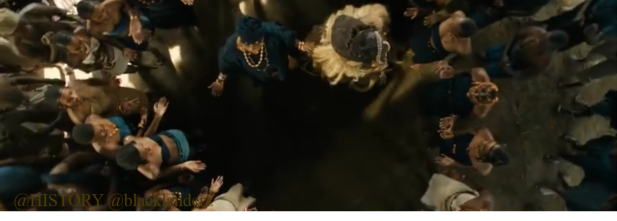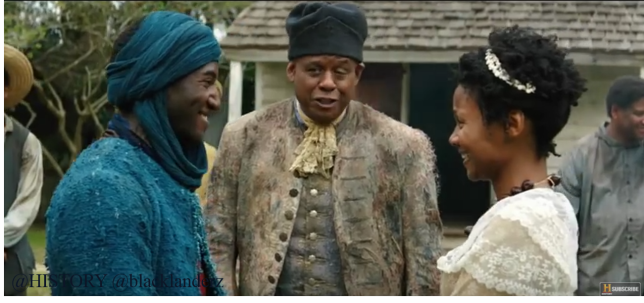A Millennial’s View – The New Roots Miniseries: Part 1
By Amanda-Rae Prescott
‘Roots’ will allow new audiences to experience this epic family saga with a new vision that is both inspiring and tremendously entertaining. We are proud that HISTORY will be able to bring new life to this powerful story that remains as important today as it did when the original ‘Roots’ first premiered.
~ Paul Buccieri, President of A&E and HISTORY
Nearly 40 years ago I had the privilege to be a part of an epic television event that started an important conversation in America. I am incredibly proud to be a part of this new retelling and start the dialogue again, at a time when it is needed more than ever.
~ LeVar Burton, Co-Executive Producer, HISTORY
I have no memories of the world stopping in 1977 to see the original Roots miniseries based on the Alex Haley novel Roots: The Saga of an American Family. Roots is a historical portrait of American slavery recounting the journey of one family’s will to survive, endure and ultimately carry on their legacy despite enormous hardship and inhumanity. Spanning multiple generations, the lineage begins with young Kunta Kinte who is captured in his homeland in The Gambia and transported in brutal conditions to colonial America where he’s sold into slavery. Throughout the series, the family continues to face adversity while bearing witness and contributing to notable events in U.S. history – including the Revolutionary and Civil Wars, slave uprisings and eventual emancipation (Source).
At some point in school, I saw a few isolated scenes in grade school when the teacher wanted to illustrate the horrors of slavery in America. My memory is far too fuzzy to really appreciate it at the time. Earlier this month, I picked up the book from the library. I read it in a week, even with crying breaks and attending to the other necessities of life such as sleeping and eating. Alex Haley wrote a very complicated family history that would present quite a challenge for a television production.
During the first two episodes, I learned very quickly not to expect this adaptation to be a replica of the book. The goal of the new series is a looser adaption that still packs the same emotional punch for viewers who have had little to no experience with the original series or the books. Alex Haley’s extensive research and characterizations still form the backbone of the series. Overall, the first two episodes maintains an excellent balance of continuing the gist of the book narrative while adding original scenes and new interpretations.
Kunta Kinte (Malachi Kirby) comes from a village named Juffure, a town in The Gambia. Life in mid-18th century Africa isn’t often seen in American period dramas, but these scenes are masterfully executed. The Mandinka people, ethnic group in the town, aren’t exotic eye candy. They have families, traditions, and a distinct culture. Kunta learned how to be a warrior, how to tame wild horses, and other survival skills. As Kunta faces many emotional and physical challenges as an adult, all of earlier experiences are seen in flashbacks throughout the series. Kunta is highly aware of slavery being a threat to his way of life in this series, but this change adds to the emotional impact when the slave traders abduct him.
The standout scenes in Epi1 are also the most violent. The first is the failed attempt to get away from the slave traders. The second is during the torturous voyage to America. Kunta and the other slaves attempt a mutiny. The captain uses cannon fire like a rifle along with beheading to terrify the slaves into submission. Later on, Kunta is whipped until blood is pouring down his back for running away from the plantation and resisting using his new name Toby. I knew it was going to happen, but I was still shocked by how violent it was. I cried after reading the scene in the book, and it was even more brutal hearing the screams and seeing the wounds.
One of the most interesting reoccurring themes in Epi1 is the portrayal of how certain groups of people are just as guilty as the slave owners in chattel slavery. Members of various African tribes were lured by money to assist white men in their brutality. Poor whites, including Scottish and Irish people, worked on plantations as overseers or captured runaway slaves. White women married to slave owners were technically property themselves, but they enforced white racial superiority in domestic settings.
Through his friendship with Fiddler (Forest Whitaker), Kunta learns to adjust to life in America. He comes to terms with never seeing his family in Africa again, but he also refuses to become a complacent slave. Epi 2 starts 10 years later during the Revolutionary War. He heard about Lord Dunmore’s proclamation to free Virginia slaves if they joined the British Army. Kunta finds other escaped slaves and even a few Native Americans who are hoping for freedom or territorial independence after the war. The British use the former slaves as easily expendable battering rams knowing full well they had no intentions of honoring their promise. Kunta remembers his lessons on the river and fights his way through the battle only to be recaptured by paddy rollers (runaway slave hunters).
The book mentions Kunta running away at least four times, but he never joined the army. These scenes show not only his fight against complacency, but also serve as a useful teaching moment.
Kunta’s owner, Master Waller (James Purefoy), sells Fiddler and him to his brother, Dr. William Waller (Matthew Goode). Later, Kunta’s foot is cut off to prevent any more escape attempts. The maiming along with the long recovery period follows closely the intensity of the same scenes in the book. Kunta comes out of the ordeal a changed man. Initially, he rejected the possibility of starting a family in America, but now has developed feelings for the woman who acted as his nurse, Belle (Emayatzy Corinealdi). Along with love and marriage, he has a new position as a carriage driver.
For most of Epi 2, the trials of slavery shift from physical violence to the psychological affects of entrenched racism. The center of emotional attention also shifts from Kunta to his daughter Kizzy (Anika Noni Rose-adult; Emyri Crutchfield-teen). Although she learns the ways of her Mandinka forefathers, she also becomes best friends with Missy (G. Hannelius), who is Master Waller’s niece. She teaches Kizzy how to read, yet expects her only to use it when it pleases her. Missy’s white friends are all too quick to play mistress and slave with Kizzy.
Kunta’s worst fears for Kizzy are realized at the end of the episode. She falls in love with a boy named Noah (Mandela Van Peebles). Kunta warned her not to get involved, but she disobeys. He knows that Kizzy is old enough to get taken advantage of or be forced to sleep with men she doesn’t love in order to make new slaves. Noah is caught and Master Waller punishes her by selling her south. Missy reveals her true colors by declaring she wanted to buy Kizzy so they could keep being “friends” forever. Her new owner, Tom Lea (Jonathan Rhys Meyers) rapes her resulting in the birth of her son, who Lea names George.
Kizzy’s story follows the book quite closely even accounting for the condensing of time. She grew up enslaved, but still recognizes the importance of honoring her Mandinka heritage. The ending of Epi2 comes full circle as Kizzy holds her son George up to the sky the same way Kunta held her.
The first half of Roots successfully brings an American classic to a new generation. Although there are fears that only showing slavery stories limits the possibilities for Black History on television, the second half of Roots will show Kunta Kinte’s descendants gaining their freedom.
HISTORY® premiered “Roots” on Memorial Day 2016, airing over four consecutive nights at 9 p.m. EST beginning Monday, May 30th.









3 thoughts on “A Millennial’s View – New Roots Miniseries: Part 1”